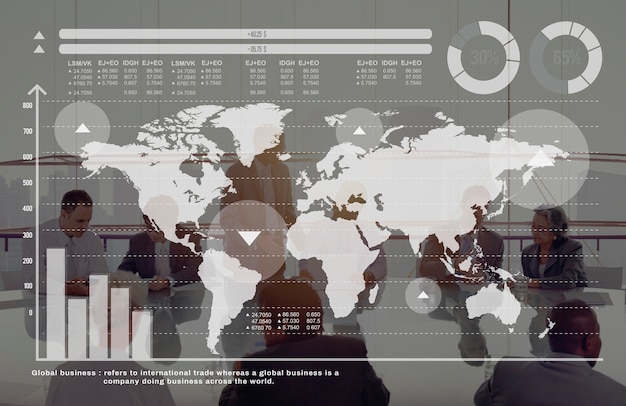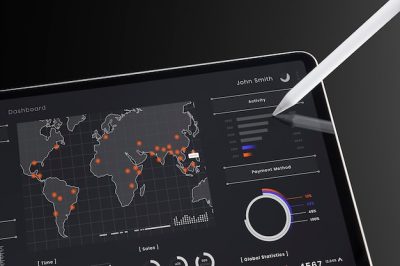The Role of Data Analytics in the Global Economy
Data analytics has become a critical tool for organizations of all sizes and industries in today’s fast-paced and data-driven global economy. The ability to analyze large amounts of data and uncover meaningful insights is transforming the way businesses operate, making data analytics a key factor in driving economic growth and competitiveness.
We cannot discuss the role of data analytics in the global economy without first understanding what data really is and where it originates from.
What is data?
The English word “data” is derived from the Latin word “datum” (singular), which denotes the “thing given.”
Data is any information that has been altered into a variety of formats for processing, analysis, management, and transfer. The name itself acts as a broad term that encompasses several concepts and academic fields, including mathematics and statistics. Information can come in the form of text, numbers, or even voice, video, or graphics, depending on how it is categorized. The range is wide and continuously shifting as our environment does.
Today, organizations rely more and more on data collection and analysis to support business expansion, choose long-term strategies, and draw in a wider audience. However, the big question remains, where does it originate from? The phrase “data analysis” may convey the idea that it only recently become well-known, but the history of data is much longer than that. Unlike what we think, it has been around for a lot longer. Data was present, but it wasn’t like the data we have today, it’s been used by people for ages, and they’ve worked hard to develop and inventing new uses for it.
A BRIEF HISTORY OF DATA
In 19000 the ISHANGO BONE also known as Tally stick, which was found in UGANDA and is considered to be one of the first examples of prehistoric data storage, provides the first indications of data collection and storage.
In 1663, by keeping track of the mortality rate, hat manufacturer John Grant became the first individual to comprehend and use data analysis to resolve a problem. This is how the concept of data analytics was first established.
Sir Henry Furnese, a prominent banker, was described by Richard Miller Davins in his encyclopedia of 1865 as having benefited from information by actively obtaining and acting on it before his rivals. This made clear that when developing a corporate plan, data and empirical proof were more trustworthy than instinct. Those who valued knowledge improved the concept further.
Herman Hollerith created a machine in the 1890s that was instrumental in completing the 1890 census.
The magnetic tape, created by Fritz Pfleumer in the 1900s, served as a model for the development of the floppy disk and hard disk drives, which eventually became storage concepts
The “data table” concept was developed by computer scientist Edgar Codd to describe data attributes in columns and values in rows, often known as the “codes relational model.”
Due to the expansion of the internet, data has become more and more popular. Thanks to Sir Tim Berners Lee’s invention Hypertext and hyperlinks made it simple to distribute information and link resources
And 1997 Data has become even more accessible to everyone with access to a computer or mobile device with the 1997 introduction of Google.
with this being the end of our timeline in the history of data, every development in technology, data science, machine learning, or artificial intelligence, new method of creating and disseminating knowledge arises with every advancement in technology, data science, machine learning, or artificial intelligence.
Having gone through the history of data, it’s time to understand how to utilize it to its fullest potential in the present. We will begin by talking about data analysis.
Data Analytics is the collection, transformation and organization of data in order to draw conclusions, make predictions and drive informed decision making. It is an essential tool for comprehending market trends and providing individualized service to customers and it has grown and altered over time while also providing many benefits.
A BRIEF HISTORY OF DATA
In 19000 the ISHANGO BONE also known as Tally stick, which was found in UGANDA and is considered to be one of the first examples of prehistoric data storage, provides the first indications of data collection and storage.
In 1663, by keeping track of the mortality rate, hat manufacturer John Grant became the first individual to comprehend and use data analysis to resolve a problem. This is how the concept of data analytics was first established.
Sir Henry Furnese, a prominent banker, was described by Richard Miller Davins in his encyclopedia of 1865 as having benefited from information by actively obtaining and acting on it before his rivals. This made clear that when developing a corporate plan, data and empirical proof were more trustworthy than instinct. Those who valued knowledge improved the concept further.
Herman Hollerith created a machine in the 1890s that was instrumental in completing the 1890 census.
The magnetic tape, created by Fritz Pfleumer in the 1900s, served as a model for the development of the floppy disk and hard disk drives, which eventually became storage concepts
The “data table” concept was developed by computer scientist Edgar Codd to describe data attributes in columns and values in rows, often known as the “codes relational model.”
Due to the expansion of the internet, data has become more and more popular. Thanks to Sir Tim Berners Lee’s invention Hypertext and hyperlinks made it simple to distribute information and link resources
And 1997 Data has become even more accessible to everyone with access to a computer or mobile device with the 1997 introduction of Google.
with this being the end of our timeline in the history of data, every development in technology, data science, machine learning, or artificial intelligence, new method of creating and disseminating knowledge arises with every advancement in technology, data science, machine learning, or artificial intelligence.
Having gone through the history of data, it’s time to understand how to utilize it to its fullest potential in the present. We will begin by talking about data analysis.
Data Analytics is the collection, transformation and organization of data in order to draw conclusions, make predictions and drive informed decision making. It is an essential tool for comprehending market trends and providing individualized service to customers and it has grown and altered over time while also providing many benefits.

Applications Of Data Analytics in The Global Economy
Financial Services
Data analytics is being used to improve risk management and fraud detection in the financial services industry. By analyzing financial data, organizations can identify patterns and trends that may indicate potential fraud, allowing them to take action to prevent losses.
Healthcare
Data analytics is being used to improve patient outcomes by analyzing patient data to identify trends and predict future health outcomes. By using predictive analytics, healthcare organizations can better understand patient needs and provide targeted and effective care.
Education
It helps in the evaluation, collection, examination, and description of data about students and their unique situations for the purposes of understanding and simplifying learning and the environments in which it occurs.
Security
It helps in compliance, risk analysis, fraud detection, security analysis, trade surveillance, and abnormal trading patterns
Web and Digital Media
Data analytics helps in Ad targeting analysis, forecasting and optimization, abuse prevention, social graph and profile segmentation.
Retail
Data analytics helps retailers in merchandising and market basket analysis, campaign management, customer loyalty programs, supply chain management, event and behavior-based targeting, and consumer segmentation.
Manufacturing
Data analytics is being used to optimize production processes and improve quality control by analyzing production data to identify inefficiencies and areas for improvement. By streamlining production processes and improving quality control, organizations can increase efficiency, reduce costs, and improve product quality.
The Future of Data Analytics in the Global Economy
The use of data analytics is rapidly growing, and its impact on the global economy is only set to increase in the coming years. Some of the key trends and developments to watch in the field of data analytics include:
- The increasing use of artificial intelligence and machine learning: These technologies are transforming the way data is analyzed, enabling organizations to uncover even deeper insights and make more informed decisions.
- The growth of the Internet of Things: The increasing number of connected devices is generating vast amounts of data, which will require more advanced data analytics tools and techniques to process and interpret.
- The rise of big data: The increasing volume of data being generated is creating new opportunities for businesses to leverage data analytics to inform decision-making and drive business growth.
In Conclusion
Data analytics is playing an increasingly important role in the global economy. By providing organizations with valuable insights and driving efficiency, data analytics is helping organizations to stay ahead of the curve and compete in today’s fast-paced and data-driven world.


